*Camunda Platform 8, our cloud-native solution for process orchestration, launched in April 2022. Images and supporting documentation in this post may reflect an earlier version of our cloud and software solutions.
You’ve deployed Camunda and have been successfully running processes there for a while. It’s becoming more and more popular, and managing the users via the web Admin app is becoming more cumbersome and time consuming. Single sign-on (SSO) or an external authentication and authorization server seems like a great solution, so how do you make that work?
Question: Can a SSO implementation be done in Camunda?
The High Level Answer
This is a very popular topic, and one that has about as many answers as you can dream up. Much of this depends on what you plan to use to facilitate your SSO capabilities. We’ll explore a few examples here.
The first thing to understand is the authentication method provided by Camunda. You can read about the Basic Authentication method, which is what most of the solutions are based on.
You can therefore provide your own implementation, add it to the web.xml (as described in the basic auth example), and all requests should be authenticated using your implementation.
This only solves the authentication part of the issue, as authorization details must be provided in Camunda itself (usernames and groups need to exist, etc.) but this is a great starting point.
The Camunda consulting team provides a more complete solution using the Camunda Spring Boot starter with Spring Security. Find this project on the Camunda Consulting GitHub.
Likewise, there is also a Camunda JBoss SSO example and a Keycloak example.
These examples, combined with the documentation, can assist in implementing a custom SSO solution.
The Detailed Implementation Answer
Since practical, hands-on information can be the most useful, let’s take a look at how to implement a Keycloak user authentication server in front of Camunda. Keycloak is also open source, so it’s a perfect complement to Camunda as an authentication server, and you can use it for SSO for a large number of applications.
To get started, download a copy of Keycloak. Use either the regular distribution or the Docker version as either will work for these purposes. This post uses the Keycloak v15.0.2 WildFly distribution.
Here, we download the distribution and run standalone.sh in the keycloak-15.0.2/bin directory.
Note: Though I’ll show examples using unsecured http, I don’t recommend authentication over anything but TLS (https). You’ll be passing usernames and passwords back and forth, and doing that unencrypted is a terrible idea.
By default, Keycloak starts up listening to http://127.0.0.1:8080/auth; point your browser there, and you will initially be asked to create the first user, who will be your admin user.
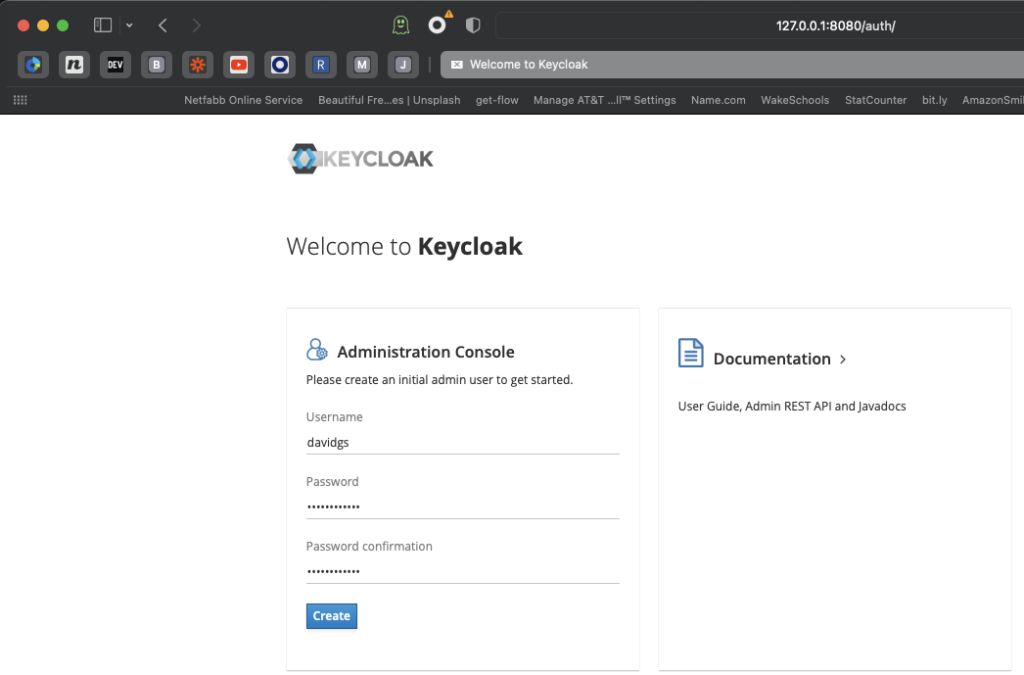
You can then use that new user to log in to the Keycloak administration page. The first thing you will need to do is create a new realm. You could use the master realm, but this is generally considered bad practice.

We are going to call our realm camunda-id.

Now that you have a new realm, you’ll need to create a new client in that realm for the actual authentication to happen. There are a few settings that you have to get right or Keycloak will not function correctly. The first is that this server will be using the confidential access type.

The second one is the Redirect URI. This is where our first dilemma arises. Keycloak is running on port 8080, but that’s also the default port for Camunda Platform 7 Run. One of them will have to move. Since we’ve already started Keycloak on port 8080, we will move Camunda Platform 7 Run to port 8181.

Getting the redirect URI correct is one of the most common problems in getting Keycloak to work as an authentication server.
Next, enable service accounts as we will be using these.
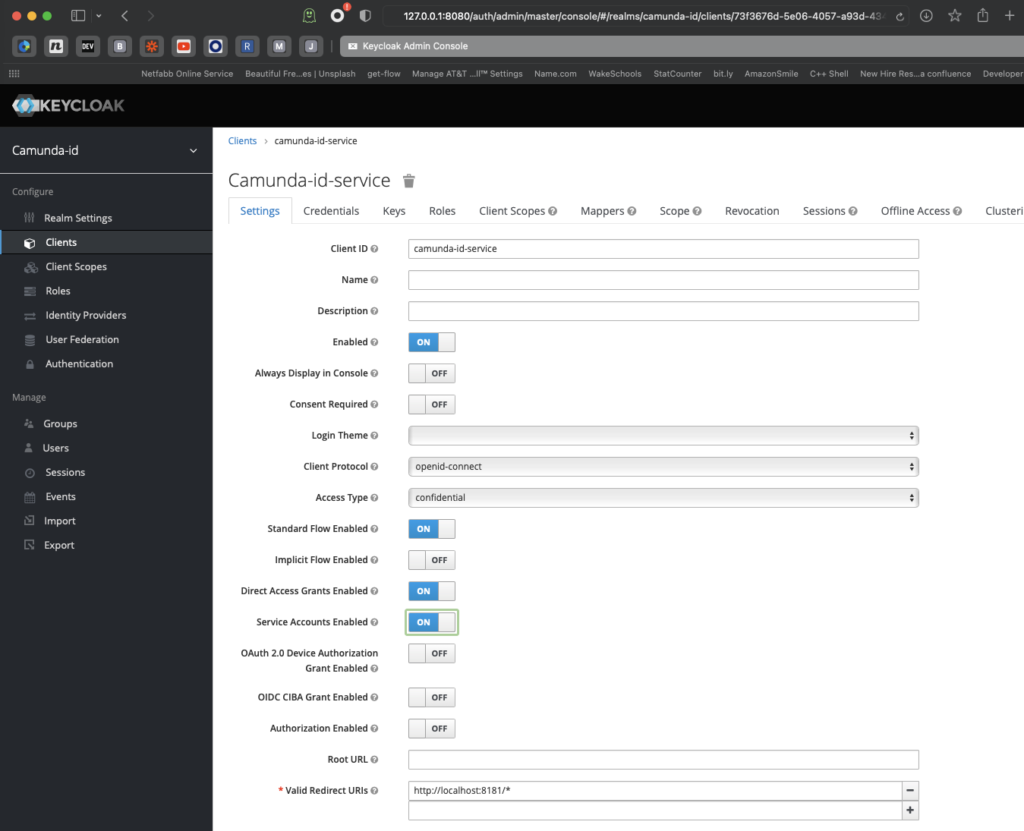
The final setting to pay attention to (since it’s not a default setting) is turning on the Use Refresh Tokens for Client Credentials Grant. This setting is under the OpenID Connect Compatibility Mode submenu. Don’t forget to save your configuration.

Next, we’ll create an admin group for our Camunda realm.

You must assign some roles to the realm client, so click on Clients in the sidebar, and note a tab called Service Account Roles. This is where we will assign roles.
Under Client Roles, select realm-management and choose the following available roles: query-groups, query-users, and view-users.
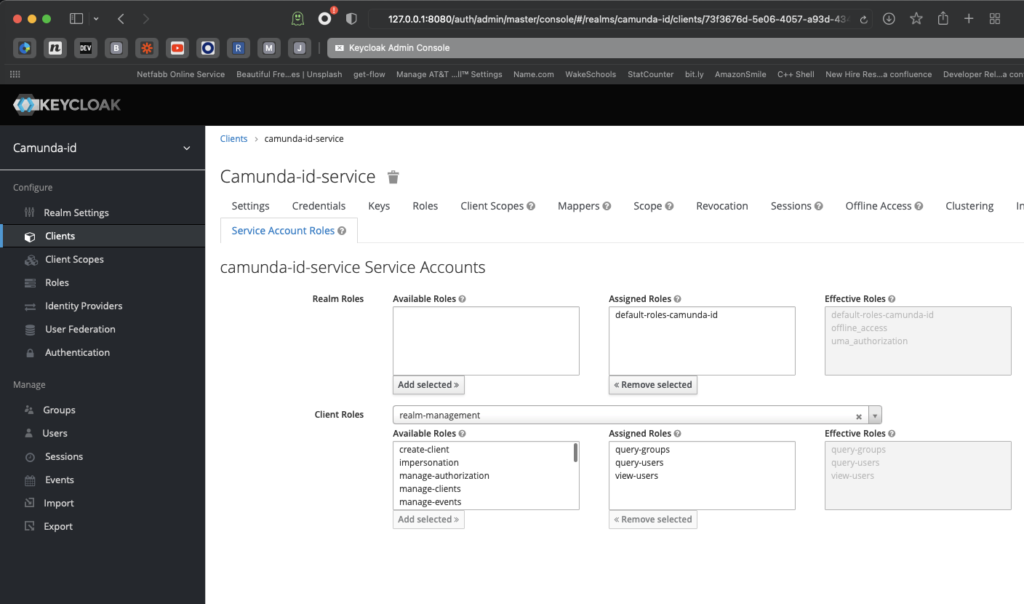
We’re almost there, I promise!
Finally, create a user or two who can log in to Camunda Platform 7. This setup will not enable the “registration” option, so the users should already exist.
Time to Get Camunda Platform 7 Running
Now that we have a functioning instance of Keycloak, it’s time to get Camunda Platform 7 Run going so we can use the Keycloak service to authenticate.
We use Camunda Platform 7 Run for this exercise.
Start by editing the default.yml file in the configuration directory.
Add the following lines:
# Camunda Keycloak Identity Provider Plugin
plugin.identity.keycloak:
keycloakIssuerUrl: http://localhost:8080/auth/realms/camunda-id
keycloakAdminUrl: http://localhost:8080/auth/admin/realms/camunda-id
clientId: camunda-id-service
clientSecret: <copy from your client secret on Keycloak Server>
useUsernameAsCamundaUserId: true
useGroupPathAsCamundaGroupId: true
administratorGroupName: camunda-admin
disableSSLCertificateValidation: trueFind your client secret in the Keycloak Admin interface under Clients > Credentials.
While editing your default configuration files, remove the following lines:
camunda.bpm:
admin-user:
id: demo
password: demoHere’s the complete default.yml file:
# Find more available configuration properties on the following pages of the documentation.
# https://docs.camunda.org/manual/latest/user-guide/camunda-bpm-run/#configure-camunda-bpm-run
# https://docs.camunda.org/manual/latest/user-guide/spring-boot-integration/configuration/#camunda-engine-properties
run:
# https://docs.camunda.org/manual/latest/user-guide/camunda-bpm-run/#cross-origin-resource-sharing
cors:
enabled: true
allowed-origins: "*"
auth.enabled: true
server:
port: 8181
# Camunda Keycloak Identity Provider Plugin
plugin.identity.keycloak:
keycloakIssuerUrl: http://localhost:8080/auth/realms/camunda-id
keycloakAdminUrl: http://localhost:8080/auth/admin/realms/camunda-id
clientId: camunda-id-service
clientSecret: b9975493-1e13-4ef5-8d09-2a789fe3d1bb
useUsernameAsCamundaUserId: true
useGroupPathAsCamundaGroupId: true
administratorGroupName: camunda-admin
disableSSLCertificateValidation: true
# datasource configuration is required
spring.datasource:
url: jdbc:h2:./camunda-h2-default/process-engine;TRACE_LEVEL_FILE=0;DB_CLOSE_ON_EXIT=FALSE
driver-class-name: org.h2.Driver
username: sa
password: sa
# By default, Spring Boot serves static content from any directories called /static or /public or /resources or
# /META-INF/resources in the classpath. To prevent users from accidentally sharing files, this is disabled here by setting static locations to NULL.
# https://docs.spring.io/spring-boot/docs/current/reference/htmlsingle/#boot-features-spring-mvc-static-content
spring.web.resources:
static-locations: NULLFinally, obtain the extension for the Platform and install it. Get the latest version of the extension at Maven Central. Download the jar file and put it in the userlib directory, which is also in the configuration directory with your default.yml file.
If all of that is done, when you start your Camunda Platform 7 instance you should see the following line:
KEYCLOAK-01001 PLUGIN KeycloakIdentityProvider$$EnhancerBySpringCGLIB$$5a974bdb activated on process engine defaultNow, if you try to log in with the default demo:demo username:password combination, you’ll see the following message:

Remember the earlier note that the users must already exist? That’s where we are now. Let’s head back to our Keycloak Admin interface and create a user.

Set their password for good measure. I turned off the Temporary flag here so the user won’t be forced to reset their password.

If we go back to the Camunda instance, we can now log in as the newly-created user.
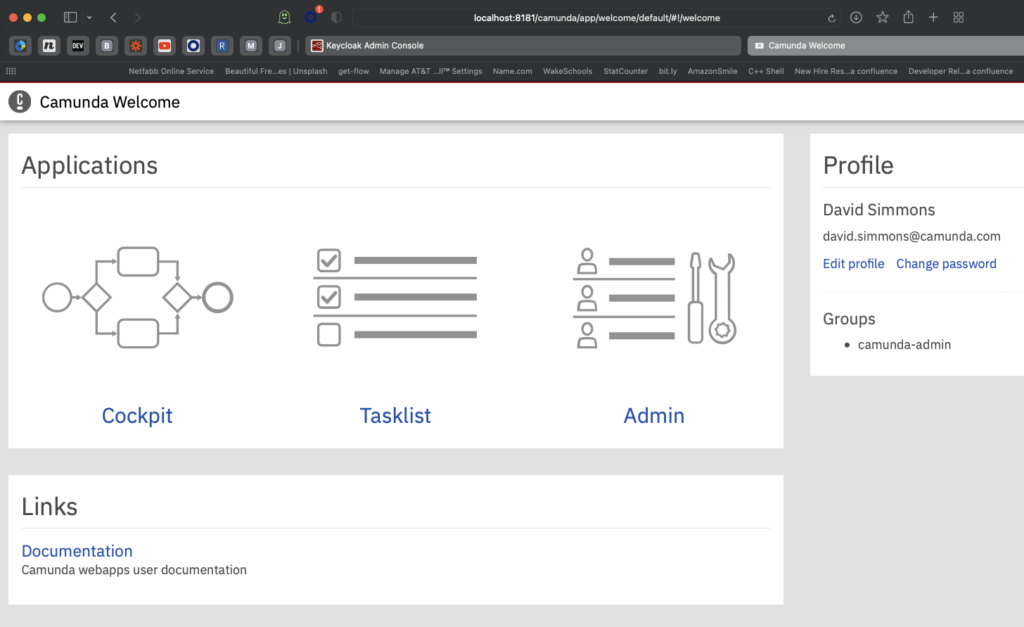
Bonus Configuration
The drawback with this setup, of course, is that users must already exist in Keycloak before they can log in to Camunda Platform 7. What if we want users to be able to register themselves?
It turns out that’s not as hard to manage as you might imagine. First, if we go back to our Keycloak instance and look at our client configuration, we will see that there is an account page enabled. If we go to that page, we can register for a new account.
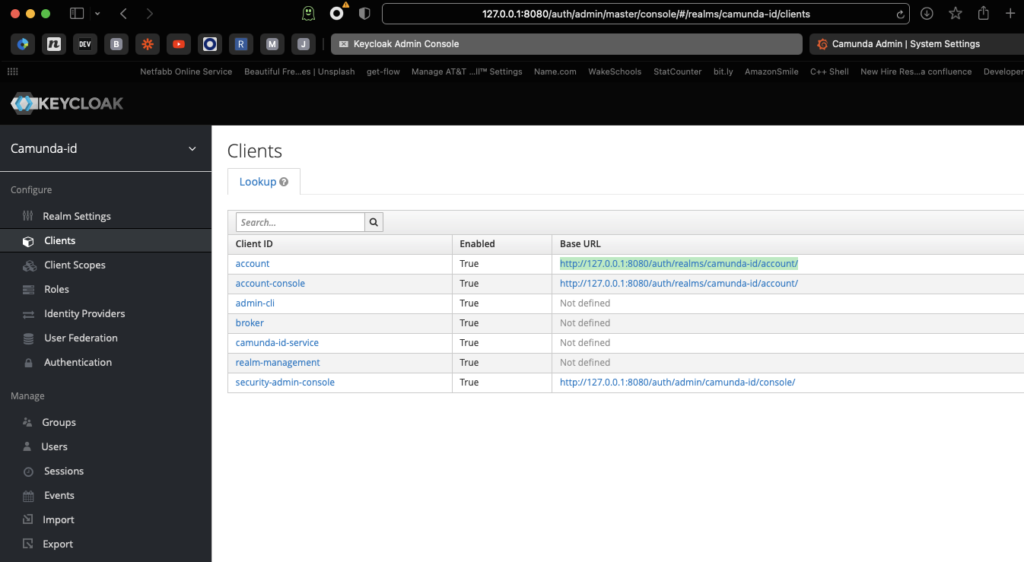
There, you’ll also find a page with information about accounts. In the top corner, you’ll notice a Sign In button which allows you to register a new account.
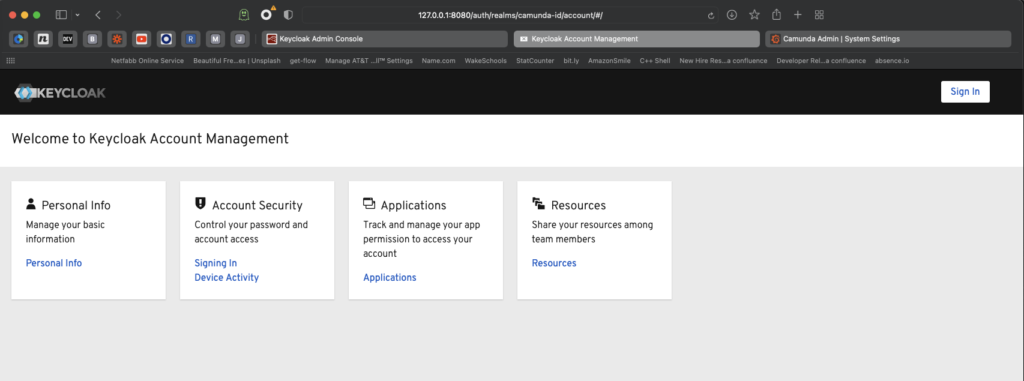

You now have a self-service registration and authorization system for your Camunda Platform 7 instance.

